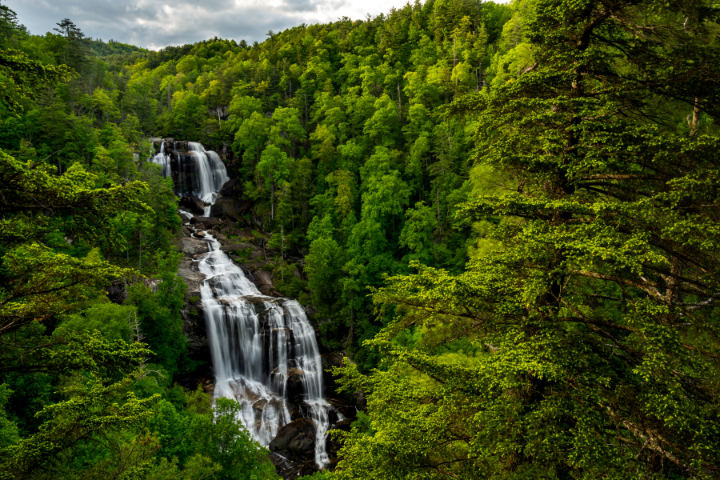 The USDA Forest Service released the final revised Nantahala and Pisgah Forest plan that will guide future management of the national forests in western North Carolina.
The USDA Forest Service released the final revised Nantahala and Pisgah Forest plan that will guide future management of the national forests in western North Carolina.
“The forest plan is a framework to address incredibly complex challenges like climate change and invasive species, impacts from development on adjacent private lands, and high levels of visitor use,” said James Melonas, forest supervisor of the National Forests in North Carolina. “Ensuring our forest ecosystems are healthy and resilient is critical to long-term sustainability of all the habitats and ecosystem benefits on which we all depend.”
In developing the plan, the Forest worked with representatives of other agencies, local government, tribes, partner and collaborative groups, and individuals to consider the best available science and various approaches to managing the forests.
The planning team developed a balanced plan that supports the multiple uses and benefits of national forests, including recreation, water, wilderness and wildlife habitat, healthy and resilient forests, and sustainable management. The new plan specifically emphasizes the ways people use the forest and the places that are important to them.
The revised forest plan was built with tribal input and enables the Forest Service to partner with tribes to co-manage resources while honoring traditional ecological knowledge and protecting places of significance to tribes.
“One example of the revised plan in action is the new Tribal Forest Protection agreement the Forest Service has with the Eastern Band Cherokee Indians,” said Melonas. “This agreement, which began with tribal consultation on the forest plan, enables us to co-steward the forests for shared values with the EBCI.”
The plan is centered around four themes that came out of public engagement during the revision process. These themes are connecting people to the land, sustaining healthy ecosystems, providing clean and abundant water, and partnering with others.
“We can do more together than alone. That’s why partnerships are the backbone of the plan,” said Michelle Aldridge, planning team lead. “The plan is explicit about our commitment to ensure that we welcome new voices and diverse perspectives to create an environment where everyone is welcome, valued, and treated equitably.”
Using a science-based approach, the plan provides a vision for each ecosystem on the forest. Special places and rare species are recognized and protected in the plan for unique ecological, biological, scenic, and cultural values.
The plan recommends 49,000 acres for newly recommended wilderness, in addition to the 66,000 acres of designated wilderness already found on the forest. The plan also recommends nine newly eligible wild and scenic rivers, in addition to the ten currently eligible, and three existing. Wild and scenic rivers are maintained for their free-flowing nature and outstanding, remarkable values.
The new plan focuses on forest resilience in the face of climate change to ensure the Forest Service can sustain these forests for current and future generations, and that they will continue to provide benefits such as clean water, high value recreation opportunities, and diverse wildlife habitat.
The plan makes the biggest commitment to old growth in decades. It increases the designated old growth network to about 25% of the forest where the Forest Service will work to ensure the development of old growth characteristics. In addition to the 265,000-acre designated old growth network, hundreds of thousands of acres of forest outside the network will continue to age and progress to old growth conditions over time.
The plan also recognizes the need for more young, open forests and restoring species such as oak. The plan will lead to a more diverse forest that has young, mature and old forest characteristics. This diversity makes forests more resilient to insects, disease and climate change.
“Our current forests are what grew up after extreme logging practices more than 100 years ago, before these lands were national forests. The trees are now mostly the same age and size,” Aldridge said. “We need more young and open forest for wildlife species including bats, ruffed grouse, pollinators, and rare species, such as the golden-winged warbler.”
In addition to a focus on ecosystem health, the plan prioritizes sustainable recreation. The Nantahala and Pisgah National Forests are among the most visited forests in the country and that visitation is increasing every year. Ensuring a quality recreation experience and equitable access to the outdoors is important to local economies, tourism, and community well-being in western North Carolina.
The revised plan will ensure the forest is using the latest trail design principles and working with recreation clubs, volunteer groups, and others to help in long-term trail maintenance and recreation management planning, which is key to continuing to provide a quality experience for increased visitors in the years to come.
“The revised plan has been developed with extensive input over many years,” said Melonas. “We appreciate the passion, creativity, and patience of all our partners and communities working with us to build a plan that reflects multiple values while ensuring our national forests are sustained for generations to come.”
The final plan, environmental impact statement, and record of decision are available at:
http://www.fs.usda.gov/goto/nfsnc/nprevision.
For more information, visit www.fs.usda.gov/nfsnc or follow the National Forests in North Carolina on Facebook (www.facebook.com/nfsnc) or Twitter (www.twitter.com/NFsNCarolina).





